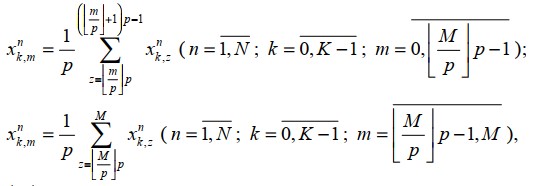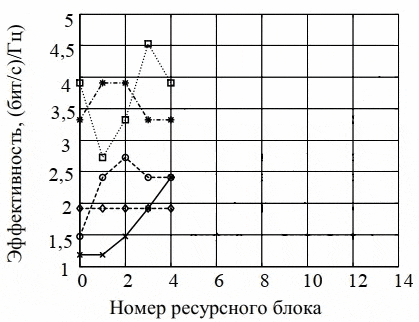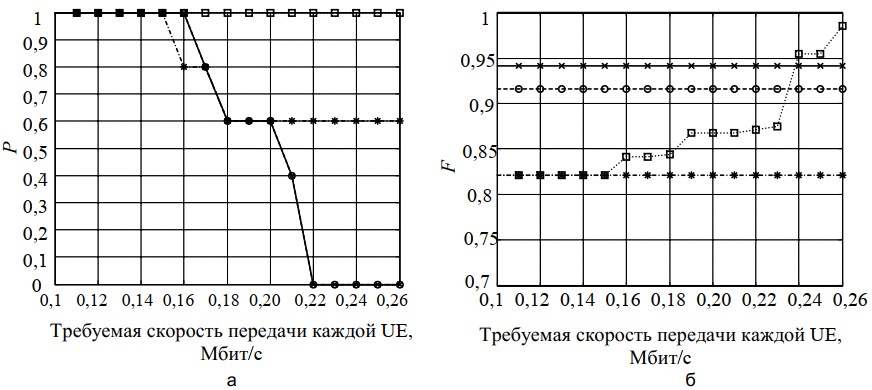Abstract
This master's work is not completed yet. Final completion: June 2020. The full text of the work and materials on the topic can be obtained from the author or his head after this date.
Content
- Annotation
- Introduction
- 1. The mathematical model of the distribution of resource blocks in the downward channel
- 2. Analysis of the decisions of the distribution block planning problem
- Conclusion
- List of sources
Annotation
The results of developing a mathematical model for scheduling time-frequency resource of the descending communication channel for the LTE. The proposed model is aimed at providing guaranteed quality of service wireless users by allocating the user stations required transmission speeds. A comparative analysis of the proposed model with existing methods from the point of view of overall efficiency of the downward communication channel, the degree of balancing throughput and the probability of allocating the user stations required transmission speed. It is shown that the proposed the model in the context of high requirements for speed of transmission of user stations, in comparison with the known methods, 5-20% to increase the degree of balancing of the bandwidth of the downward communication channel, and 40-100% increase in the probability of allocating the user stations required transmission speed.
Introduction
In the LTE (Long Term Evolution) developed by 3GPP (3rd Generation Partnership Project), one of the most effective ways to increase productivity and improve key indicators of quality of service (Quality of Service, QoS) is the improvement of network protocols and mechanisms responsible for the scheduling of available network resources. To such resources, first all are a temporary resource — OFDM symbols (Orthogonal frequency-division multiplexing) and frequency resource — frequency podniesie. Under OFDM symbol refers to the period of time over which the amplitude and phase modulated subcarriers unchanged. It should be noted that the solution of the problem of the allocation of radio resource in the first place is based on the QoS requirements and may be assigned to the system radio resource management (Radio Resource Management, RRM), namely on the scheduler (scheduler). In LTE, as in HSDPA or WiMAX, mechanisms of planning resources of the descending channel (DownLink) is not defined by the standard, leaving the choice of equipment manufacturers of base stations (evolved NodeB, eNodeB). The result of solving the problem of distribution of frequency and time resources should be fixing blocks planning (Scheduling Block, SB) for the user stations (User Equipment, UE) in the downward communication channel of the same frame. Unit planning is the lowest structural element allocated to one user station and formed two adjacent resource blocks (Resource Block RB) on the same subcarrier (subcarrier). In work was analyzed the methods of allocating frequency and time resources, using the algorithm Round Robin Scheduler. The algorithm Round Robin Scheduler involves the allocation of equally time-frequency resource for each UE. In the underlying implementation of Round Robin Scheduler allocates each UE a time interval within which the UE obtains exclusive access to the channel. The rate of data transmission of the UE is limited to the actual value of the ratio signal/noise (signal to noise Ratio, SNR). There were also analyzed the methods that use the algorithm Max C/I Ratio, which provides a time-frequency resource the user station with the best SNR values, ensuring the fair distribution of the resource between the UE. In addition, the paper analyzed the methods of allocating frequency and time resources, using the algorithm of proportional fair allocation maintenance (Proportional Fair Scheduling). The analysis showed that the algorithm Proportional Fair Scheduling helps UE, which has a high SNR value, while ensuring a sufficient number of frequency and time resources of the UE with the worst value SNR. The analysis showed that the provision of access frequency-time resource of LTE technology the most appropriate would be a mechanism that includes features of Round Robin and Max C/I Ratio algorithms. The choice of algorithm depends on the category and size of the load. The correct choice of algorithm to grant access is particularly important at high load. The use of the algorithm Proportional Fair Scheduling aims at the use of interactive "best effort" data class to avoid a situation when some UE never get access to frequency-time resource. The specified class of service (Class of Service, CoS) delivers data to UE as possible without guarantees speed of data transmission. Improving the quality of service when planning czestochowianka resource of each UE should be aimed at providing the guaranteed transmission speed with the ability to access additional (non-guaranteed) bandwidth. However, none of of the evaluated mechanisms are not able to provide such a CoS. As a result analysis decided the need to develop mathematical models of planning czestochowianka resource in the downlink communication of LTE technology, is formulated as the problem of the distribution of SB to provide the guaranteed transmission speed of UE.
1. The mathematical model of the distribution of resource blocks in the downward channel
The proposed mathematical model is directed for application in wireless networks LTE, using frequency and temporary division of channels. When developing mathematical the model takes into account the fact that the smallest structural unit of radio resource, which control in task scheduling, is SB. In the proposed LTE three types of allocation of resources. The developed model is aimed at the use of the zero form (Resource Allocation Type 0), involving the Union RB in the so-called group of resource blocks (resource block groups, RBG) allocated to the UE. The number of RB included in one RBG ( p) depends on the width of the frequency channel. If the division of the number of RB for the parameter p does not give integer values, the extreme RBG will be smaller than p [8]. To take account of the number podkatov allocated for information transfer in the downward communication channel, the mathematical model introduced the concept of a matrix of configurations of the descending channel — rectangular matrix with number of rows corresponding to the number of configurations of the frame ( L ), and the number of columns corresponding to the number podkatov ( K ) in the frame, i.e.
 |
(1) |
where h1,k = 1, if k-th podcat when I-th configuration is used for the transmission of information in downward communication channel or 0 otherwise.
In the course of solving the problem of block allocation planning in the proposed model it is necessary to provide for calculation of Boolean control variable (Xnk,m), which determines the order of block allocation planning: Xnk,m = 1, if m-th unit planning for k-m potcake allocated n-th UE or 0 otherwise.
When calculating the unknown variables Xnk,m, you must perform a number of important conditions of constraints:
-
the
- Condition a fixation m-th SB of the downward communication channel for the transmission of k-th subframe, not more than one UE:

(2) - Condition for allocating UE downlink only scheduling blocks:
- The condition of assigning to the n -th UE the number of SBs providing the necessary transmission rate in downlink when using the modulation and coding scheme (Modulation and Coding Scheme, MCS):
- The condition for combining RB into RGB sizes satisfying the width of the frequency channel used:
- Ghosh A., Zhang J., Muhamed R., Andrews J. Cr. Fundamentals of LTE. — Prentice Hall, USA, 2010. — 464 p.
- 3GPP TS 36.211. 3rd Generation Partnership Project; Technical Specification Group Radio Access Network; Evolved Universal Terrestrial Radio Access (E-UTRA); Physical Channels and Modulation (Release 11). — Valbonne, France: Sophia Antipolis, 2012. — 108 p.
- Dahlman E., Parkvall S., Skold J., Beming P. 3G Evolution — HSPA and LTE for Mobile Broadband. — Academic Press, 2008. — 608 p.
- Iosif O., Banica I. On the Analysis of Packet Scheduling in Downlink 3GPP LTE System // The Fourth International Conference on Communication Theory, Reliability, and Quality of Service (CTRQ 2011). — 2011. — P. 99–102.
- Galaviz G., Covarrubias D. H., Andrade A. G., Villarreal S. A resource block organization strategy for scheduling in carrier aggregated systems // EURASIP Journal on Wireless Communications and Networking. — 2012. — P. 107–124.
- Kawser M. T., Farid H. M. A. B., Hasin A. R., Sadik A. M. J., Razu I. К. Performance Comparison between Round Robin and Proportional Fair Scheduling Methods for LTE // International Journal of Information and Electronics Engineering. — 2012. — V. 2. — № 5. — P. 678–681.
- 3GPP TS 36.213. 3rd Generation Partnership Project; Technical Specification Group Radio Access Network; Evolved Universal Terrestrial Radio Access (E-UTRA); Physical layer procedures (Release 11). — Valbonne, France: Sophia Antipolis, 2012. — 104 p.
- Girici T., Zhu C., Agre J.R., Ephremides A. Proportional Fair Scheduling Algorithm in OFDMABasedWireless Systems with QoS Constraints // Journal of communications and networks. — 2010. — V. 12. — № 1. — P. 30–42.
- Adibah M. R. H., Kumbesan S., Riyaj B., Leijia W. Modeling and simulation of packet scheduling in the downlink long term evolution system // Proceedings of 15th Asia-Pacific Conference on Communications (APCC 2009). — 2009. — P. 68–71.
- Ермолаев В. Т. Флаксман А. Г. Теоретические основы обработки сигналов в системах мобильной радиосвязи. — Нижний Новгород: НГУ им. И. Н. Лобачевского, 2010. — 107 с.
 |
(3) |
 |
(4) |
 |
(5) |
where [] is the designation of rounding the number to the nearest integer down. Condition (5) is used to combine the planning blocks of the extreme group of resource blocks, the sizes of which may be less than p .
The calculation of the desired variables (1) in accordance with the constraint conditions (2) - (5) is advisable to carry out in the course of solving the optimization problem, providing a minimum or maximum of a pre-selected quality criterion for solving the distribution problem SB. The SB distribution problem can be solved using the optimality criterion aimed at maximizing the total downlink performance. Thus, the optimality criterion will take the following form:
 |
(6) |
by considering the conditions-restrictions (2)–(5). Using the optimality criterion (6) together with conditions-restrictions (2)–(5) is aimed at providing the guaranteed transmission speed with the ability to access additional (non-guaranteed) bandwidth, that CoS corresponds to a subclass of B.
The problem from a mathematical point of view is objective mixed integer nonlinear programming — MINLP (Mixed Integer NonLinear Programming). Variable used in optimality criteria (6) is an integer, constraints on the searched variables, (2) to (4) are linear and the constraints (5) — linear.
2. Analysis of the decisions of the distribution block planning problem
With the aim of decision analysis in planning of resource blocks in the downlink communication received using known methods and proposed models (2) to(6), consider the example
in which block allocation planning in the downward communication channel, we used the following initial data: the number of UE, N = 5; number of SB that are generated during transmission of one time slot, M = 15; the number of OFDM symbols forming one resource block,
NRBsymb =7; values of efficiency MCS signals the UE to various resource blocks — in accordance
in Fig. 1; split channels — TDD; number podkatov used to transmit information
in a downward channel of communication, K=4 (configuration of the frame– № 1 [1, 2]); the amount of SB included in the
one RBG, p=2.
The Solution is formulated in the optimization problem was obtained using system MATLAB R2012b. Have been involved in this program minlpAssign optimization package TOMLAB. All user stations have the same required transmission speed, which took the value of RnTRB=0-0, 26 Mbps
As shown by the simulation results, the overall performance of the downward communication channel when using the known methods throughout the measurement interval did not change and made for a method Round Robin 0,9622 Mbit/s for the method is Proportional Fair – 1,2377 Mbit/s, and for the method Max C/I Ratio – 1,4192 Mbit/s. The overall performance of the downward communication channel when using the proposed model (2) to(6), section RnTRB=0-0,15 Mbit/s had a maximum value corresponding to the method of Max C/I Ratio, and was 1,4192 Mbit/s. On the interval RnTRB=0-0,26 Mbit/s the overall performance decreased by 3%, to the value 1,3641 Mbit/s.

Fig. 1. The values of the efficiency of MCS signals custom stations
for various resource
blocks used in the example.
(Animation: 4 frames, 4 cycles of repetition, of 80.7 KB)
In Fig. 2A, simulation results showing the dynamics of changes of the degree balancing the bandwidth of the downward channel between the UE. The degree of balancing of throughput was defined according to expression [10]
 |
(7) |
where Rin — transfer rate allocated n-th UE on i-th measurement interval, n=1,N. As shown by the simulation results (Fig. 2A), the degree of balancing of the bandwidth of the downward communication channel when using the known methods throughout the measurement interval has not changed and amounted to 0,9421 Round Robin method, the Proportional method for Fair — 0,9163, and for the method Max C/I Ratio — 0,8214. The degree of balancing of the bandwidth of the downward communication channel when using the proposed model (2) to(6), section RnTRB=0-0,15 Mbit/c had a minimum value corresponding to the method of Max C/I Ratio, and was 0,8214. On the interval RnTRB=0,15-0,26 Mbit/s the degree of balancing throughput increased to 0,9859.

Fig. 2. The degree of balancing of the bandwidth of the downward communication channel (a)
and probability
the allocation of the UE required transmission rate (b).
In Fig. 2B, the results of calculation of probability of compliance with the requirements on the transmission speed allocated to all UE. The probability of fulfilling the requirements for transmission speed of i-th measurement interval is determined in accordance with the expression
 |
(8) |
As shown by the simulation results, changing the required transmission rate from 0,15 Mbit/s and above, all the known methods do not provide the desired value of the transmission rate to all user stations. The requirement for speed of transmission of known methods is provided only at low values of RnTRB, namely, RnTRB=0-0,15 Mbit/s. Using the proposed model (1)–(7) provides for the allocation of the required the transfer rate of the UE on the whole range of dimension RnTRB = 0-0,26 Mbit/s.
Conclusion
Found that one of the main challenges in wireless networks operating using LTE technology, is the task of ensuring the required quality of service, which includes the allocation of user network stations necessary transfer rate in a downward the channel of communication. It is also established that the provision of the required transmission rate, the LTE technology can be achieved by solving the problem of block allocation scheduling in a descending channel connection. In this regard, we have analyzed the existing mechanisms for the distribution of units planning between user stations in a downlink wireless network communication, operating using LTE technology. On the basis of the identified disadvantages of the known solutions of the proposed mathematical model, represented by a number of linear and nonlinear terms-restrictions. The novelty of the model is the formulation of the problem of distribution blocks planning tasks of redistribution of the available throughput the ability of the descending channel LTE technology to transmit information in the direction of the user stations taking into account their territorial remoteness (type of modulation system and coding). Comparative analysis showed that in conditions of high requirements to the speed of transmission of user stations using model (1) to(7), in comparison with the known methods, allows to 5-20% increase in the degree of balancing of the bandwidth of the downward communication channel (Fig. 2, a), and also on a 40-100% increase in the probability of allocating the user stations required speed the transmission (Fig. 2, b). However, the performance of the downward communication channel, in conditions of high requirements of transmission speed, 3% less performance obtained using the method Max C/I Ratio, and 10-42% more performance using the methods of Round Robin and Proportional Fair.The use of the proposed model is aimed at providing each user station with a guaranteed transmission speed in a downlink channel with the ability to access an additional (non-guaranteed) bandwidth. This in service classes corresponds to subclass B of CoS, while other methods do not guarantee allocation of the required transmission speed, which is in the service classes CoS corresponds to subclass A
